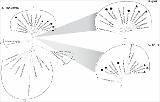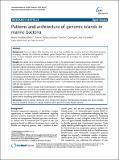Por favor, use este identificador para citar o enlazar a este item:
http://hdl.handle.net/10261/58599COMPARTIR / EXPORTAR:
 SHARE SHARE
 CORE
BASE CORE
BASE
|
|
| Visualizar otros formatos: MARC | Dublin Core | RDF | ORE | MODS | METS | DIDL | DATACITE | |

| Título: | Patterns and architecture of genomic islands in marine bacteria |
Autor: | Fernández-Gómez, Beatriz CSIC ORCID; Fernàndez-Guerra, Antoni CSIC ORCID; Casamayor, Emilio O. CSIC ORCID ; González, José M.; Pedrós-Alió, Carlos CSIC ORCID; Acinas, Silvia G. CSIC ORCID | Fecha de publicación: | 29-jul-2012 | Editor: | BioMed Central | Citación: | BMC Genomics 13(1): 347 (2012) | Resumen: | Abstract Background Genomic Islands (GIs) have key roles since they modulate the structure and size of bacterial genomes displaying a diverse set of laterally transferred genes. Despite their importance, GIs in marine bacterial genomes have not been explored systematically to uncover possible trends and to analyze their putative ecological significance. Results We carried out a comprehensive analysis of GIs in 70 selected marine bacterial genomes detected with IslandViewer to explore the distribution, patterns and functional gene content in these genomic regions. We detected 438 GIs containing a total of 8152 genes. GI number per genome was strongly and positively correlated with the total GI size. In 50% of the genomes analyzed the GIs accounted for approximately 3% of the genome length, with a maximum of 12%. Interestingly, we found transposases particularly enriched within Alphaproteobacteria GIs, and site-specific recombinases in Gammaproteobacteria GIs. We described specific Homologous Recombination GIs (HR-GIs) in several genera of marine Bacteroidetes and in Shewanella strains among others. In these HR-GIs, we recurrently found conserved genes such as the β-subunit of DNA-directed RNA polymerase, regulatory sigma factors, the elongation factor Tu and ribosomal protein genes typically associated with the core genome. Conclusions Our results indicate that horizontal gene transfer mediated by phages, plasmids and other mobile genetic elements, and HR by site-specific recombinases play important roles in the mobility of clusters of genes between taxa and within closely related genomes, modulating the flexible pool of the genome. Our findings suggest that GIs may increase bacterial fitness under environmental changing conditions by acquiring novel foreign genes and/or modifying gene transcription and/or transduction. | Versión del editor: | https://doi.org/10.1186/1471-2164-13-347 | URI: | http://hdl.handle.net/10261/58599 | DOI: | 10.1186/1471-2164-13-347 | Identificadores: | http://dx.doi.org/10.1186/1471-2164-13-347 |
| Aparece en las colecciones: | (CEAB) Artículos (ICM) Artículos |
Ficheros en este ítem:
| Fichero | Descripción | Tamaño | Formato | |
|---|---|---|---|---|
| 1471-2164-13-347.xml | 182,49 kB | XML | Visualizar/Abrir | |
| 1471-2164-13-347-S4.TIFF | 395,97 kB | TIFF |  Visualizar/Abrir | |
| 1471-2164-13-347-S1.DOCX | 64 kB | Microsoft Word XML | Visualizar/Abrir | |
| 1471-2164-13-347-S8.DOCX | 63,2 kB | Microsoft Word XML | Visualizar/Abrir | |
| 1471-2164-13-347-S2.XLS | 115,5 kB | Microsoft Excel | Visualizar/Abrir | |
| 1471-2164-13-347-S6.TIFF | 1,83 MB | TIFF |  Visualizar/Abrir | |
| 1471-2164-13-347-S7.TIFF | 4,56 MB | TIFF |  Visualizar/Abrir | |
| 1471-2164-13-347.pdf | 3,29 MB | Adobe PDF |  Visualizar/Abrir | |
| 1471-2164-13-347-S3.DOCX | 127,59 kB | Microsoft Word XML | Visualizar/Abrir | |
| 1471-2164-13-347-S9.DOCX | 40,1 kB | Microsoft Word XML | Visualizar/Abrir | |
| 1471-2164-13-347-S5.TIFF | 6,44 MB | TIFF |  Visualizar/Abrir |
CORE Recommender
PubMed Central
Citations
17
checked on 22-abr-2024
SCOPUSTM
Citations
32
checked on 16-abr-2024
WEB OF SCIENCETM
Citations
29
checked on 23-feb-2024
Page view(s)
284
checked on 24-abr-2024
Download(s)
744
checked on 24-abr-2024
Google ScholarTM
Check
Altmetric
Altmetric
Artículos relacionados:
NOTA: Los ítems de Digital.CSIC están protegidos por copyright, con todos los derechos reservados, a menos que se indique lo contrario.
